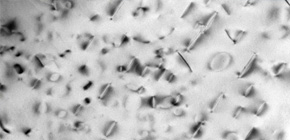
Tripled thermoelectric conversion efficiency achieved with bottom-up nanostructured bulk Silicon
The technology developed by the group holds great promise!
A group of researchers from Osaka University, Kyushu Institute of Technology, and Osaka Prefecture University have succeeded in increasing the thermoelectric conversion efficiency of Silicon (Si) by more than three times by employing bottom-up nanostructuring of bulk Si.
Researchers at Osaka University's Graduate School of Engineering:
• KUROSAKI Ken (Associate Professor)
• AIKEBAIER Yusufu (Specially Appointed Researcher)
• YAMANAKA Shinsuke (Professor)
This group's achievement will possibly lead to wider application of practical use of thermoelectrics (TE) thanks to greater efficiency in the conversion of waste heat into high-quality electric energy.
In addition to unsatisfactory efficiency levels, conventional TE materials contain toxic and/or rare elements such as tellurium and lead, effectively becoming barriers to practical use of such materials in thermoelectric power generation. On the other hand, although Si is a non-toxic and naturally abundant element, heretofore its thermoelectric conversion efficiency has been poor because of its high thermal conductivity. Theoretically, nanostructuring materials only reduce their thermal conductivity without affecting their electric properties.
However, this group succeeded in making bulk nanostructured Si through the use of a simple and reproducible method while simultaneously increasing the material's thermoelectric conversion efficiency by greater than three times.
Thermoelectric generation has been used as an electric source for nuclear batteries in planetary exploration spacecraft because of its small size, light weight, and maintenance-free characteristics.This group has achieved significant progress in thermoelectric conversion efficiency using Si, a development that will accelerate the practical use of thermoelectric generation. Specifically, this group's technology holds promise for use in direct power generation systems making use of exhaust heat from production plants and refuse incineration plants and as exhaust heat regeneration systems for enhancing automobile fuel efficiency.
Abstract
The effectiveness of thermoelectric (TE) materials is quantified by the dimensionless figure of merit (zT). An ideal way to enhance zT is by scattering phonons without scattering electrons. Here we show that, using a simple bottom-up method, we can prepare bulk nanostructured Si that exhibits an exceptionally high zT of 0.6 at 1050 K, at least three times higher than that of the optimized bulk Si. The nanoscale precipitates in this material connected coherently or semi-coherently with the Si matrix, effectively scattering heat-carrying phonons without significantly influencing the material's electron transport properties, leading to the high zT.
To learn more about this research, please view the full research report entitled "Bottom-up nanostructured bulk silicon: A practical high-efficiency thermoelectric material" at this page of the Royal Society of Chemistry website.
Related links :
